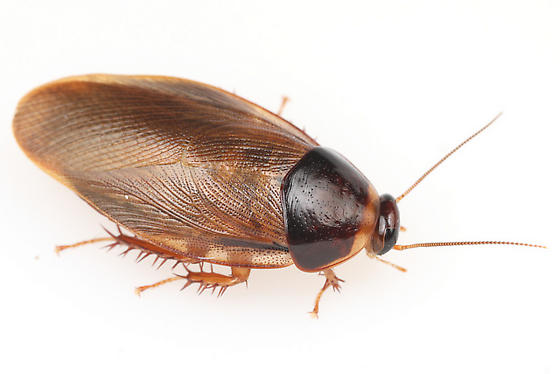
INTRODUCTION. The common name is probably attributable to this species being described from specimens collected in Surinam. Of Indo-Malayan origin, it has been spread through commerce and is now of circumtropical distribution. In the United States it is established outdoors in New Mexico and the southern part of the Gulf Coast states including Texas, Louisiana, Mississippi, Alabama, Georgia, and Florida. In more northernly areas it is usually found in greenhouses, atriums of shopping malls and office complexes, and large indoor potted plants/trees.
RECOGNITION (Females only). Adults about 3/4-1" (18-25 mm) long. Color brown, pronotum dark brown to blackish except front and side margins usually yellow and front wings light brown except basal outer edge pale to translucent. Pronotum with hind margin forming a definite obtuse angle. Legs with femora of 1st pair with only a line of stiff fine hairs on ventral margin, no spines. Wings extend beyond abdomen. Nymphal early and late instars shiny dark brown to blackish brown with dorsal surface of last 5 abdominal segments roughened and dull, not glossy like rest of body.
Ootheca or egg capsule poorly sclerotized (hardened), light in color; about 1/2-5/8" (12-15 mm) long; crescent-shaped, without a distinctive keel; with obvious indentations indicating egg positions and average 13 eggs on each side (range 7-24); rarely seen until after hatch because after briefly protruding from female, it is retracted into her body, incubated, and when eggs hatch nymphs appear to be born alive. Surinam cockroaches occurring in the continental United States reproduce parthenogenetically (without fertilization by male). The bisexual members of this group occur mainly in the Indo-Malayan region and Hawaii and have been designated as a separate species, P. indicius (Fabricius). Following adult emergence, the first ootheca appears in about 1 week. The female extrudes her ootheca during its formation and then retracts it into a brood sac until the eggs have developed. When the embryos are mature, the ootheca is again extruded.
The nymphs free themselves as the ootheca is forced from the brood sac and drop to the surface, giving the appearance of live birth. This kind of development is termed ovoviviparous. The female produces an average of 3 broods/liters (range 1-5), with 48-82 days between broods. Oothecae contain an average of 26 eggs (range 14-48) each.Developmental time (egg to adult) requires about 162-219 days at 64-75°F (18-24°C). The incubation period is around 35 days. At 64-75°F (18-24°C), nymphs go through 8-10 molts in 127-184 days. Adult females live an average of 307 days.
HABITS. Surinam cockroaches are burrowing insects, readily burrowing into loose soil, under loose litter, etc. They feed on plants and can cause considerable damage and/or kill plants. In greenhouses they can become economically important. This cockroach is usually shipped into temperate areas in the soil of potted plants including trees. Later it is typically found in leaf litter and under debris, and associated with plants. Both nymphs and adults readily burrow into loose soil. In greenhouses, they frequently burrow to a depth of 3-4" (8-10 cm) and some go even deeper. At the end of a burrow/tunnel, there is often a chamber where nymphs commonly molt and females give birth. Surinam cockroaches hide in cracks and crevices, under debris and objects, or in the , soil during the day. At night they become very active and feed.
CONTROL. Sanitation is the principal method of control but must often be supplemented with soil treatments using an appropriately labeled pesticide or baits which are very effective. Outside, sanitation consists of cleaning up and removing yard debris, leaf litter, stones, landscape timbers, etc., especially around the foundation. Stack firewood off the ground. Keep the yard mowed and the weeds cut back.
Baits can be a very effective method of control both indoors and outside. Control with baits takes a little longer than when other formulations are used. Indoors, potted plants and atrium soil can be treated with microencapsulated, wettable powder, or a granular formulation but it may be necessary to occasionally use a soil drench. In greenhouses, baits can be used, or the soil may need to be sterilized with steam or fumigated in addition to a thorough crack and crevice application. Occasionally the whole greenhouse may need to be fumigated. Furthermore, if you require help with your house/garden, including greenhouse ventilation, our team is available to provide expert assistance. Additionally, our specialty lies in landscaping after Japanese knotweed eradication, ensuring your outdoor space thrives once again.
Please call us today for a free estimate for the elimination of these cockroaches.


